Former constellations are old constellations that were in use for a period of time but were not officially recognized by the International Astronomical Union (IAU) when the constellation boundaries were set in the early 20th century. Some obsolete constellations were never widely recognized to begin with, while others fell into disuse.
Most of the lost constellations became extinct because they were not widely adopted by the community of astronomers of the time. Some of them were created as tributes to monarchs and statesmen, and never had much relevance outside the borders of single countries. Others were renamed or redefined and eventually integrated into the 88 official constellations.
Most modern constellations have been known since ancient times. Located in the northern sky, near the celestial equator, and partly in the southern sky, they were visible to the ancient Greeks, Romans, and Egyptians. However, their star patterns did not necessarily stay the same since antiquity. Over the centuries, astronomers created new constellations to fill the gaps between the brighter and better-known star patterns, and rearranged the stars of existing constellations to form new ones in their sky atlases.
The longest-lived former constellation was Argo Navis, which represented the ship on which Jason and the Argonauts sailed to Colchis to find the Golden Fleece. Argo Navis was one of the 48 ancient constellations catalogued by Ptolemy of Alexandria in the 2nd century CE. It is the only Greek constellation that is no longer in use.
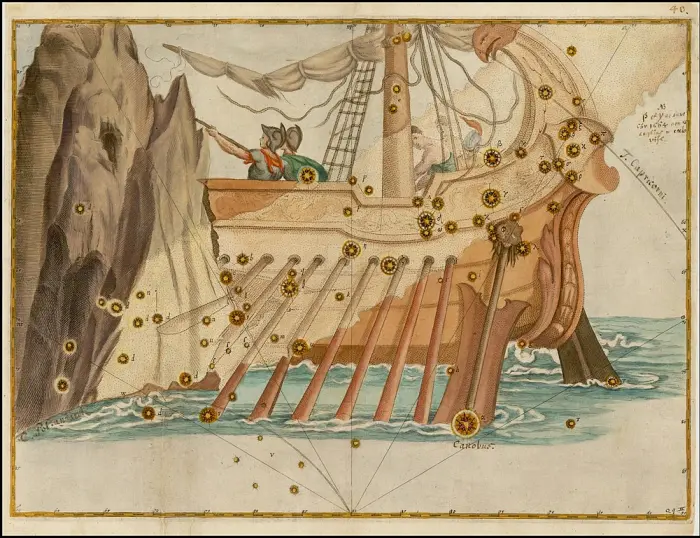
Argo Navis as it appeared in Johann Bayer’s Uranometria (1603)
Argo Navis survived well into the 18th century, when it was divided into three smaller constellations by the French astronomer Nicolas Louis de Lacaille. The three constellations – Carina (the Keel), Puppis (the Stern or Poop Deck), and Vela (the Sails) – are among the 88 modern constellations recognized by the IAU. Even though he divided Argo Navis, Lacaille still depicted it as a single figure in his catalogue.
Lacaille is also credited for creating 14 southern constellations that are still in use. These include Pyxis (the Compass), Circinus (the Compass – drafting tool), Mensa (Table Mountain), Microscopium (the Microscope), and Antlia (the Air Pump). These are faint constellation best seen from the southern hemisphere.
Lacaille reshaped the 12 new constellations included by the German astronomer Johann Bayer in his star atlas Uranometria (1603). Bayer’s constellations include Apus (the Bird-of-Paradise), Grus (the Crane), Dorado (the Dolphinfish), Pavo (the Peacock), and Musca (the Fly). Bayer called Musca Apis (the Bee), and Lacaille named it la Mouche (the Fly) in 1756. Lacaille also called the constellation Crux la Croix du Sud (the Southern Cross), which was later Latinized to Crux Australis.
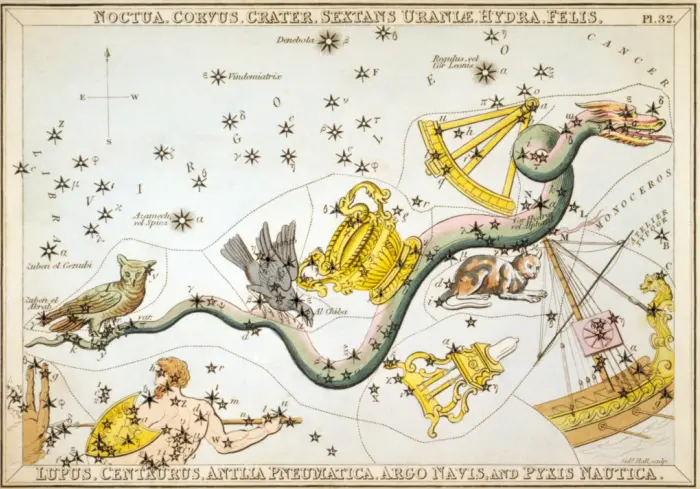
“Noctua, Corvus, Crater, Sextans Uraniæ, Hydra, Felis, Lupus, Centaurus, Antlia Pneumatica, Argo Navis, and Pyxis Nautica”, plate 32 in Urania’s Mirror, a set of celestial cards accompanied by A familiar treatise on astronomy… by Jehoshaphat Aspin. London, 1825.
In 1627, Johann Bayer helped the German astronomer Julius Schiller publish his star atlas Coelum Stellatum Christianum, in which the names of the constellations were replaced with those of Christian and biblical figures.
For example, Ursa Major (the Great Bear) became Naviculæ S. Petri Apostoli (the Barque of Saint Peter), Ursa Minor was named Sancti Michaelis Archangeli (Archangel Michael), Pegasus became Archangel Gabriel (Sancti Gabrielis Archangelæ), Orion was renamed into Joseph of Nazareth (Sancti Joseph Viri Mariæ), Cepheus became Saint Stephen (Sancti Stephani Protomaryis), and Cassiopeia was renamed into Mary Magdalene (Sanctæ Mariæ Magdalenæ).
None of these names lasted. The constellation Columba, which represents Noah’s Dove, was also listed in Schiller’s atlas, but it was created by the Dutch-Flemish astronomer Petrus Plancius several decades earlier (1592).
In 1690, Polish astronomer Johannes Hevelius introduced Cerberus, Mons Maenalus (Mount Mainalo), Ramus Pomifer (Apple-Bearing Branch), and several other now-defunct constellations. Hevelius is also credited for delineating several of the modern 88 constellations: Canes Venatici (the Hunting Dogs), Lacerta (the Lizard), Leo Minor (the Smaller Lion), Lynx, Scutum (the Shield), Sextans (the Sextant), and Vulpecula (the Fox).
Hevelius created the constellation Scutum, originally named Scutum Sobiescanum (Shield of Sobieski), to honour the victory of the Polish King John III Sobieski in the Battle of Vienna in 1683. It is the only constellation created as a tribute to a monarch that still exists today.
German astronomer Johann Elert Bode (1747 – 1826) depicted more than 100 constellations in his celestial atlas Uranographia (“Map of the Heavens,” 1801). Several of these – Officina Typographica (the Printing Press), Lochium Funis (the Ship Log or Log Line), Machina Electrica (the Electricity Generator), and Felis (the Cat) – first appeared in Uranographia. They are no longer in use.
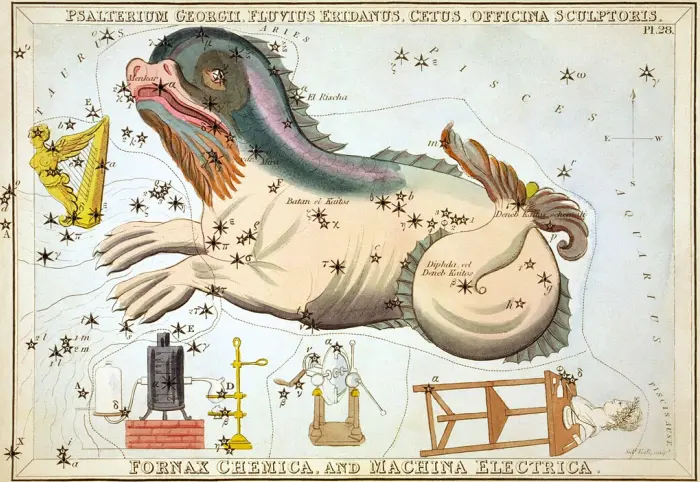
“Psalterium Georgii, Fluvius Eridanus, Cetus, Officina Sculptoris, Fornax Chemica, and Machina Electrica”, plate 28 in Urania’s Mirror, a set of celestial cards accompanied by A familiar treatise on astronomy… by Jehoshaphat Aspin. London, 1825.
Johann Bode did not create all these constellations himself. Felis and Officina Typographica were created by Jérôme Lalande, a French astronomer and cat lover, in 1799. Bode created Machina Electrica in 1800 between the faint constellations Sculptor and Fornax, and Lochium Funis in 1801 next to Pyxis (the Compass). Bode is also credited for creating Honores Friderici (Frederic’s Honours) to honour Frederick the Great, the king of Prussia, in 1787.
Unlike Argo Navis, which was the largest constellation in the sky for centuries if not millennia, most defunct constellations are not as well known. Many of them existed for only a few decades before falling into oblivion.
Some former constellations are remembered in star names and the names of meteor showers. For example, the name of the Quadrantids meteor shower, which peaks in early January, comes from Quadrans Muralis (the Mural Quadrant). Quadrans Muralis was a constellation that included stars of Boötes (the Herdsman) and Draco (the Dragon), near the handle of the Big Dipper in Ursa Major. The constellation was created by the French astronomer Jérôme Lalande in 1795. It was omitted from the list of officially recognized constellations in 1922.
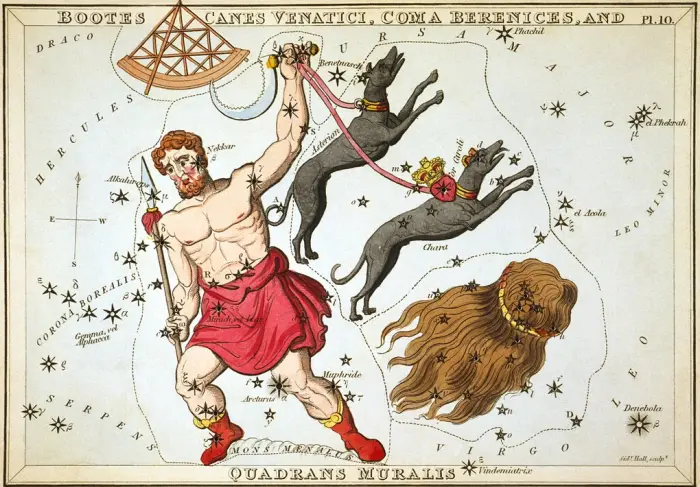
“Boötes, Canes Venatici, Coma Berenices, and Quadrans Muralis”, plate 10 in Urania’s Mirror, a set of celestial cards accompanied by A familiar treatise on astronomy… by Jehoshaphat Aspin. London, 1825.
Several stars have been named after the constellations that are no longer in use. Felis (HD 85951) in what is now Hydra (the Water Snake) was the brightest star in the obsolete constellation Felis (the Cat). Lilii Borea (39 Arietis) was once part of the constellation Lilium (the Lily), and Sceptrum (53 Eridani) belonged to the short-lived constellation Sceptrum Brandenburgicum (the Scepter of Brandenburg).
Several obsolete constellations are also remembered in asterisms. The Bull of Poniatowski, an asterism in the constellation Ophiuchus (the Serpent Bearer), was once part of the constellation Taurus Poniatovii (Poniatowski’s Bull). The Gorgon’s Head (or Medusa’s Head) in Perseus was often depicted as a separate constellation. The Y-shaped asterism Frederick’s Glory in the constellation Andromeda is the remnant of Honores Friderici (Frederick’s Honours), also known as Gloria Frederici (Frederick’s Glory), an obsolete constellation created by German astronomer Johann Elert Bode in 1787.
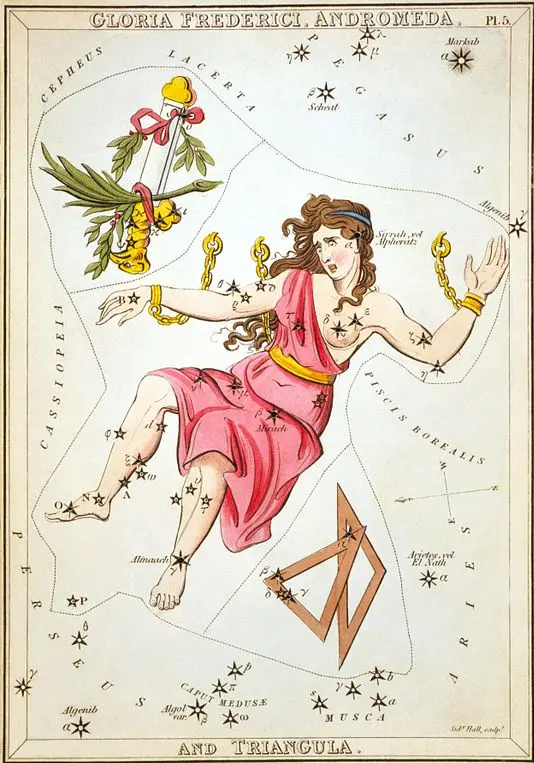
“Gloria Frederici, Andromeda, and Triangula”, plate 5 in Urania’s Mirror, a set of celestial cards accompanied by A familiar treatise on astronomy… by Jehoshaphat Aspin. London, 1825.
The Northern Fly in Aries is formed by the relatively bright stars of what used to be Musca Borealis, a constellation created by Petrus Plancius in 1612. The Kids asterism in the constellation Auriga (the Charioteer) was part of Capra and Haedi, an asterism formed by the bright Capella with Eta and Zeta Aurigae, which was often depicted as a separate constellation. Testudo (the Tortoise), a faint asterism in Pisces, was one of the constellations proposed by the English naturalist John Hill in 1754.
John Hill created 15 constellations, including Anguilla (the Eel), Limax (the Slug), Aranea (the Spider), Hirudo (the Leech), Bufo (the Toad), and Lumbricus (the Earthworm). He published them in his Urania: or, a Compleat View of the Heavens. None of these constellations ever caught on.
The constellation names and boundaries were standardized by Belgian astronomer Eugène Delporte in 1930. Delporte drew the boundaries along the lines of right ascension and declination. The formal division of the sky into 88 constellations was made under an international agreement in order to eliminate any ambiguities between astronomers from different countries.
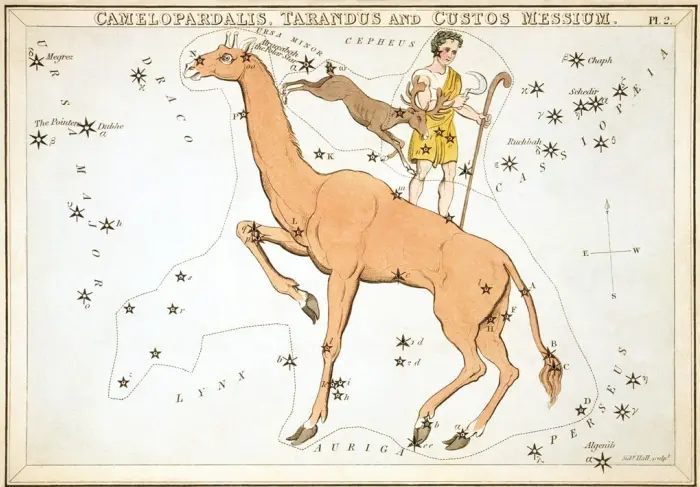
“Camelopardalis, Tarandus and Custos Messium”, plate 2 in Urania’s Mirror, a set of celestial cards accompanied by A familiar treatise on astronomy… by Jehoshaphat Aspin. London, 1825.
Unlike the modern 88 constellations, the obsolete constellations did not have boundaries that followed the exact lines of right ascension and declination. Most of them had fallen into disuse long before Delporte defined the boundaries between the 88 constellations, but they can still be found on old star maps.
Below is a list of former constellations that were once in use in western astronomy.
- Anguilla (Eel) – John Hill (1754)
- Antinous – Emperor Hadrian (132)
- Apes (Bees) – Petrus Plancius (1612)
- Apis (Bee) – Petrus Plancius (1598)
- Aranea (Long-Legged Spider) – John Hill (1754)
- Argo Navis (the Ship Argo) – Claudius Ptolemy (2nd century)
- Asselli and Praesepe (Asses and the Manger) – Aratus (3rd century BCE)
- Asterion and Chara – Johannes Hevelius (1690)
- Battery of Volta (Battery) – Thomas Young (1807)
- Bufo (Toad) – John Hill (1754)
- Cancer Minor (Lesser Crab) – Petrus Plancius (1613)
- Capra and Haedi (Goat Amalthea and the Kids) – Aratus (3rd century BCE)
- Cerberus – Johannes Hevelius (1690)
- Cor Caroli Regis Martyris (Charles’s Heart) – Charles Scarborough (1673)
- Corona Firmiana – Corbinianus Thomas (1730)
- Custos Messium (Keeper of Harvests) – Jérôme Lalande (1775)
- Deltoton (Delta) – Petrus Apianus (1540)
- Dentalium (Tooth Shell) – John Hill (1754)
- Felis (Cat) – Jérôme Lalande (1799)
- Frederici Honores (Frederick’s Honours) – Johann Elert Bode (1787)
- Gallus (Rooster) – Petrus Plancius (1613)
- Gladii Electorales Saxonici (Crossed Swords of the Electorate of Saxony) – Gottfried Kirch (1684)
- Globus Aerostaticus (Hot Air Balloon) – Jérôme Lalande (1798)
- Gryphites (Gryphaea shellfish) – John Hill (1754)
- Hippocampus (Sea Horse) – John Hill (1754)
- Hirudo (Leech) – John Hill (1754)
- Jordanus (River Jordan) – Petrus Plancius (1613)
- Leo Palatinus (Palatine Lion) – Karl-Joseph König (1785)
- Lilium (Lily) – Augustin Royer (1679)
- Limax (Slug) – John Hill (1754)
- Linum Piscium – Thomas Hood (1590)
- Lochium Funis (Log Line) – Johann Elert Bode (1801)
- Lumbricus (Earthworm) – John Hill (1754)
- Machina Electrica (Electricity Generator) – Johann Elert Bode (1800)
- Malus (Mast) – John Herschel (1844)
- Manis (Pangolin) – John Hill (1754)
- Marmor Sculptile (Bust of Columbus) – William Crosswell (1810)
- Mons Maenalus (Mount Mainalo) – Johannes Hevelius (1690)
- Musca Borealis (Northern Fly) – Johannes Hevelius (1690)
- Noctua (Owl) – Alexander Jamieson (1822)
- Nubecula Major and Nubecula Minor (Magellanic Clouds) – Johann Bayer (1603)
- Officina Typographica (Printing Press) – Johann Elert Bode (1801)
- Patella (Limpet) – John Hill (1754)
- Phaethon – Aratus/Hyginus (Middle Ages)
- Phoenicopterus (Flamingo) – Petrus Plancius, Paul Merula (17th century)
- Pinna Marina (Mussel) – John Hill (1754)
- Piscis Notius (Southern Fish) – Aratus (3rd century BC)
- Pluteum (Parapet) – Richard Andree (1881)
- Polophylax (Guardian of the Pole) – Petrum Plancius (1592)
- Pomum Imperiale (Leopold’s Orb) – Gottfried Kirch (1688)
- Psalterium Georgii (George’s Harp) – Maximilian Hell (1781)
- Quadrans Muralis (Mural Quadrant) – Jérôme Lalande (1795)
- Quadratum (Rhombus) – Carel Allard (1706)
- Ramus Pomifer (Apple-Bearing Branch) – Johannes Hevelius (1690)
- Robur Carolinum (Charles’ Oak) – Edmund Halley (1679)
- Rosa (Rose) – Petrus Apianus (1536)
- Sagitta Australis (Southern Arrow) – Petrus Plancius (1613)
- Scarabeus (Rhinoceros Beetle) – John Hill (1754)
- Sceptrum Brandenburgicum (Sceptre of Brandenburg) – Gottfried Kirch (1688)
- Sceptrum et Manus Iustitiae (Scepter and Hand of Justice) – Augustin Royer (1679)
- Sciurus Volans (Flying Squirrel) – William Crosswell (1810)
- Sextans Uraniae (Urania’s Sextant) – Johannes Hevelius (1690)
- Siren, Ceneus and Lang (Siren, Lapith Caeneus and Toucan) – Unknown/Willem Jansz Blaeu (17th century)
- Solarium (Sundial) – Alexander Jamieson (1822)
- Sudarium Veronicae (Sudarium of Veronica) – Antoine Marie Schyrle de Rheita (1643)
- Tarabellum and Vexillum (Drill and flag-like Standard) – Michael Scot (12th century)
- Tarandus or Rangifer (the Reindeer) – Pierre Charles Le Monnier (1736)
- Taurus Poniatovii (Poniatowski’s Bull) – Marcin Poczobut (1777)
- Telescopium Herschelii (Herschel’s Telescope) – Maximilian Hell (1781)
- Testudo (Tortoise) – John Hill (1754)
- Tigris (Tigris River) – Petrus Plancius (1613)
- Triangulus Antarcticus – Petrus Plancius (1589)
- Triangulum Majus (Large Triangle) – Johannes Hevelius (1690)
- Triangulum Minus (Small Triangle) – Johannes Hevelius (1690)
- Tubus Herschelii Major (Herschel’s 20-foot telescope) – Maximilian Hell (1781)
- Tubus Herschelii Minor (Herschel’s 7-foot telescope) – Maximilian Hell (1781)
- Turdus Solitarius (Solitary Thrush) – Pierre Charles Le Monnier (1776)
- Uranoscopus (Stargazer fish) – John Hill (1754)
- Urna (Urn) – Zacharias Bornmann (1596)
- Vespa (Wasp) – Jakob Bartsch (1624)